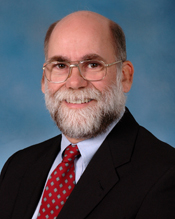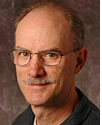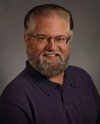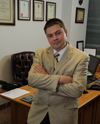
Biography - Speakers for FluoroFest 2012 - Bethesda, Maryland
Dr. Richard Thompson Ph.D., Associate Professor of Biochemistry and Molecular Biology, University of Maryland School of Medicine, Baltimore, Maryland
 Dr. Thompson received his Bachelors degree in Biology from Northwestern University and Ph.D. in Biochemistry from the University of Illinois in Urbana-Champaign, studying the structure of bacterial luciferase under Thomas Baldwin. He was a postdoctoral fellow with Joseph Lakowicz at Maryland, and an NRC Associate and subsequently a supervisory Research Chemist at the U.S. Naval Research Laboratory in Washington DC, where he received a Navy Special Act Award for Operation Desert Storm. He joined the faculty at Maryland in 1990, where his work has focused mainly on the development of fluorescence-based metal ion biosensors, and their application to problems of interest in biomedicine, metallobiochemistry and geochemistry. He serves on the editorial boards of the Journal of Fluorescence and the Journal of Biomedical Optics, is the editor of Fluorescence Sensors and Biosensors (CRC Press) and has served on the board of the International Society for Zinc Biology.
Dr. Thompson received his Bachelors degree in Biology from Northwestern University and Ph.D. in Biochemistry from the University of Illinois in Urbana-Champaign, studying the structure of bacterial luciferase under Thomas Baldwin. He was a postdoctoral fellow with Joseph Lakowicz at Maryland, and an NRC Associate and subsequently a supervisory Research Chemist at the U.S. Naval Research Laboratory in Washington DC, where he received a Navy Special Act Award for Operation Desert Storm. He joined the faculty at Maryland in 1990, where his work has focused mainly on the development of fluorescence-based metal ion biosensors, and their application to problems of interest in biomedicine, metallobiochemistry and geochemistry. He serves on the editorial boards of the Journal of Fluorescence and the Journal of Biomedical Optics, is the editor of Fluorescence Sensors and Biosensors (CRC Press) and has served on the board of the International Society for Zinc Biology.
Dr. Richard D. Ludescher Department of Food Science, Rutgers University
 Richard D. Ludescher has had a varied academic career, studying anthropology and philosophy at the University of Iowa (B.A. '73), physical biochemistry at the University of Oregon (Ph.D. '84), and muscle biophysics at the University of Minnesota, before accepting a position in food physical chemistry in 1988 at the Department of Food Science, Rutgers University where he is currently a full professor and Dean of Academic Programs at the School of Environmental and Biological Sciences. He has used both fluorescence and phosphorescence techniques to study structure, dynamics and function of proteins and protein complexes in solution, in tissues, and in the amorphous solid state. Much of his current research involves developing novel luminescent probes of quality, stability, and safety of foods and food ingredients.
Richard D. Ludescher has had a varied academic career, studying anthropology and philosophy at the University of Iowa (B.A. '73), physical biochemistry at the University of Oregon (Ph.D. '84), and muscle biophysics at the University of Minnesota, before accepting a position in food physical chemistry in 1988 at the Department of Food Science, Rutgers University where he is currently a full professor and Dean of Academic Programs at the School of Environmental and Biological Sciences. He has used both fluorescence and phosphorescence techniques to study structure, dynamics and function of proteins and protein complexes in solution, in tissues, and in the amorphous solid state. Much of his current research involves developing novel luminescent probes of quality, stability, and safety of foods and food ingredients.
Dr. Jay R. Knutson Ph.D., Chief, Optical Spectroscopy Section, Laboratory of Molecular Biophysics, NHLBI, NIH, Bethesda, Maryland
 Dr. Knutson received his Ph.D. in Physics in 1978 from the University of Minnesota, studying the structure and winds of the upper atmosphere using satellite-borne mass spectrometers with Alfred O.C. Nier. A brief AHA-MN postdoctoral fellowship with Joseph Lakowicz at Minnesota (GFWBI) followed, and from 1980-84 he was a McCollum-Pratt fellow and PhRMA fellow with Ludwig Brand at Johns Hopkins. He became a Senior Staff Fellow in NHLBI working with Raymond F. Chen in the Laboratory of Technical Development (The lab of origin of the (Robert L.)-Bowman spectrophotofluorometer), becoming Section Chief of OSS in 1992. His work focused almost exclusively on protein, membrane and DNA dynamics until recently, when moving time resolved measurement and other ultrafast laser methods into microscopes became a passion.
Dr. Knutson received his Ph.D. in Physics in 1978 from the University of Minnesota, studying the structure and winds of the upper atmosphere using satellite-borne mass spectrometers with Alfred O.C. Nier. A brief AHA-MN postdoctoral fellowship with Joseph Lakowicz at Minnesota (GFWBI) followed, and from 1980-84 he was a McCollum-Pratt fellow and PhRMA fellow with Ludwig Brand at Johns Hopkins. He became a Senior Staff Fellow in NHLBI working with Raymond F. Chen in the Laboratory of Technical Development (The lab of origin of the (Robert L.)-Bowman spectrophotofluorometer), becoming Section Chief of OSS in 1992. His work focused almost exclusively on protein, membrane and DNA dynamics until recently, when moving time resolved measurement and other ultrafast laser methods into microscopes became a passion.
Jay is a member of the JHU Society of Scholars and is a Guest Professor at East China Normal University, Shanghai
Dr Chris D. Geddes Ph.D., Professor.
 Dr Chris D. Geddes has extensive experience in fluorescence spectroscopy, particularly in fluorescence sensing and metal-fluorophore interactions, publishing over 225 peer-reviewed papers (h-index: 34) and 25 books. Dr Geddes is internationally known in fluorescence and plasmonics and his laboratory is widely attributed to the development of the Metal-Enhanced Fluorescence (MEF) and related plasmon-fluorescence technologies, securing in excess of $25 million in recent years to persue his research aspirations. He is the editor-in-chief of the Journal of Fluorescence and founding editor-in-chief of the Who's Who in Fluorescence, Annual Reviews in Fluorescence and the Annual Reviews in Plasmonics volumes. In addition, due to the labs' pioneering efforts in the fields of metallic nanoparticle-fluorophore interactions, Dr Geddes launched a Springer Journal "Plasmonics" in 2005.. Dr Geddes is Director of the Institute of Fluorescence, a department within UMBC (University of Maryland Baltimore County), which focuses on the nano-bio-technological applications of fluorescence. Dr Geddes is a permanent member of the NIH's EBIT R01 study section and chaired the NIH's Analytical and BioAnalytical SBIR study section from 2004-2009. Professor Geddes is a fellow of the Institute of Physics.
Dr Chris D. Geddes has extensive experience in fluorescence spectroscopy, particularly in fluorescence sensing and metal-fluorophore interactions, publishing over 225 peer-reviewed papers (h-index: 34) and 25 books. Dr Geddes is internationally known in fluorescence and plasmonics and his laboratory is widely attributed to the development of the Metal-Enhanced Fluorescence (MEF) and related plasmon-fluorescence technologies, securing in excess of $25 million in recent years to persue his research aspirations. He is the editor-in-chief of the Journal of Fluorescence and founding editor-in-chief of the Who's Who in Fluorescence, Annual Reviews in Fluorescence and the Annual Reviews in Plasmonics volumes. In addition, due to the labs' pioneering efforts in the fields of metallic nanoparticle-fluorophore interactions, Dr Geddes launched a Springer Journal "Plasmonics" in 2005.. Dr Geddes is Director of the Institute of Fluorescence, a department within UMBC (University of Maryland Baltimore County), which focuses on the nano-bio-technological applications of fluorescence. Dr Geddes is a permanent member of the NIH's EBIT R01 study section and chaired the NIH's Analytical and BioAnalytical SBIR study section from 2004-2009. Professor Geddes is a fellow of the Institute of Physics.
Professor David Birch Photophysics Group, Department of Physics, SUPA.University of Strathclyde, Glasgow, G4 0NG, Scotland
David Birch is Professor of Photophysics at the University of Strathclyde in Glasgow. He has published over 200 journal papers, mainly on fluorescence lifetime spectroscopy. His present research interests include fluorescence studies of molecular dynamics and structure down to the single molecule level, nanoparticle metrology, fibril formation and metabolic sensing. David studied physics at the University of Manchester where he obtained his PhD for research on diphenylpolyene fluorescence under the supervision of the late John B Birks. After holding a temporary lectureship at Manchester he moved into industry to work on high-resolution organic mass spectrometry with VG Micromass Ltd. He subsequently moved to Strathclyde University where he was appointed Professor of Photophysics in 1993. External appointments include in 1999 the Sir C V Raman Endowment Visiting Chair at the University of Madras, in 2000 a Visiting Professorship at Kyoto Institute of Technology and, from 2002, the Visiting Chair of Applied Physics at the Czech Technical University, Prague. Previously he has held research fellowships from the Royal Society, the Nuffield Foundation and the Japanese Society for the Promotion of Science. He is a Fellow of Scotland's National Academy the Royal Society of Edinburgh and a member of the Permanent Steering Committee of the Methods and Applications in Fluorescence conference series. He is Editor in Chief of the Institute of Physics journal Measurement Science and Technology, and served on the Editorial Board of SPIE's Journal of Biomedical Optics since its launch in 1995.
Dr. Ludwig Brand Professor of Biology and Professor of Biophysics, Johns Hopkins University, Baltimore MD 21218
Dr. Brand was trained at Harvard , Indiana University, Brandeis University and at the Weizmann Institute of Science . He has been on the faculty of Johns Hopkins University since 1963.
Dr. R. David Holbrook is a chemical engineer in the Surface and Microanalysis Science Division at the National Institute of Standards and Technology, whose research interests include the behavior of engineered nanoparticles and microanalysis of environmental samples.
Dr. Rose M. Cory is an assistant professor in Environmental Sciences & Engineering at the University of North Carolina Chapel Hill (UNC). She earned a B.S. in chemistry from Michigan State University in 1998, followed by M.S. at Michigan Technological University in 2001 and a Ph.D. in Environmental Engineering from the University of Colorado in 2006. Dr. Cory conducted postdoctoral research on organic matter photochemistry at the University of Minnesota, Twin Cities (2006-2008) and then at Los Alamos National Laboratory (2008-2009). Her research focuses on transformations of carbon important for global carbon cycling and water quality, which has taken her to field sites from the Antarctic to the Arctic.